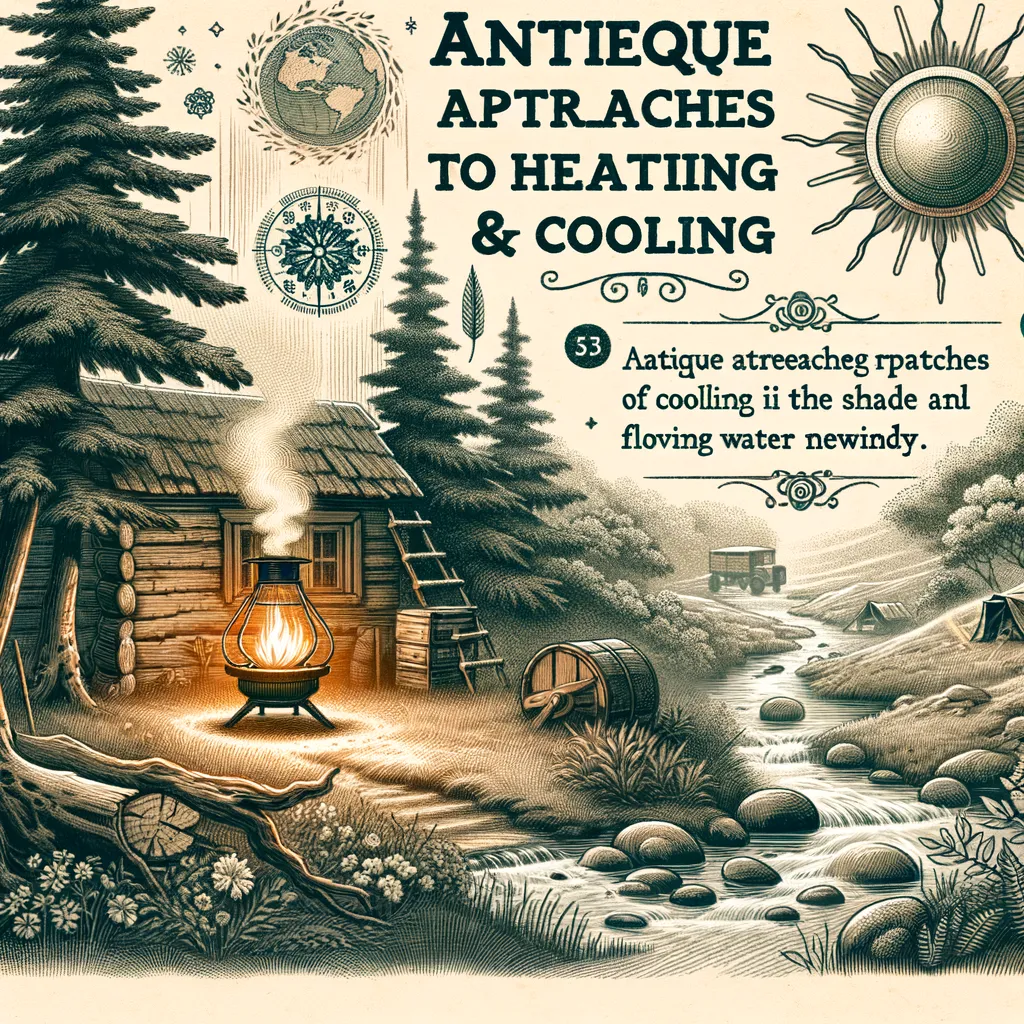Eco-Friendly Heating and Cooling: A Guide for Modern Parents Interested in Antique Methods
As modern parents, we’re constantly searching for ways to create a sustainable future for our children. With the growing concern for the environment, finding eco-friendly solutions in every aspect of life has become imperative. In the journey towards sustainability, Outdoors experiences remind us of the significant impact ancient techniques can have on our lives. This guide delves into the past to uncover antique approaches to heating and cooling that are not only eco-friendly but also effective and can be integrated into our homes today. For families looking to reduce their carbon footprint while enjoying the comforts of modern living, embracing these time-tested methods could be the key. For further information on the benefits of connecting with nature and engaging in sustainable practices, visit Outdoors Info. Now, let’s explore how we can incorporate these ancient practices into our 21st-century lives.
Antique Heating Methods That Warm the Heart and Home
In days gone by, homes were kept warm through innovative and resourceful means, long before the advent of electric heating systems. These methods, grounded in the principles of sustainability and efficiency, offer invaluable lessons for contemporary eco-conscious families.
1. Thermal Mass and Passive Solar Design
One of the most efficient ways to heat a home without consuming fossil fuels is through passive solar design. This method involves using materials that retain heat during the day and release it at night to keep indoor spaces warm. Thick stone walls, brick, and concrete are excellent examples of thermal mass that, when properly incorporated into home design, can significantly reduce reliance on conventional heating systems.
2. Masonry Heaters
Masonry heaters, an ancient European technique, present another sustainable way to warm your dwelling. These heaters are designed to absorb the heat from a fire built inside them and then slowly radiate this warmth over time. Unlike traditional wood-burning stoves or fireplaces, masonry heaters are incredibly efficient, producing more heat with less wood and reducing smoke and pollutants in the process.
3. Geothermal Heating
While geothermal heating may seem like a modern technology, the concept of using the earth’s constant underground temperature to regulate indoor climate is ancient. By circulating water or antifreeze through underground pipes, geothermal systems can heat homes in the winter and cool them in the summer, drastically cutting down on energy use and costs.
Antique Cooling Techniques That Are Naturally Effective
Similarly, our ancestors had ingenious ways of keeping cool during hot weather, utilizing natural resources and smart design to create comfortable living spaces without electricity.
1. Wind Catchers
Originating from ancient Persia, wind catchers or ‘badgirs’ are traditional architectural elements designed to catch and circulate natural breezes into buildings. This natural ventilation method can significantly reduce indoor temperatures, making it a perfect cooling solution for dry climates.
2. Evaporative Cooling
Before the invention of modern air conditioning, people used the principle of evaporative cooling to beat the heat. This technique involves placing wet fabrics or pads in front of windows or doorways, so incoming breezes are cooled by the evaporation of water. In regions with low humidity, evaporative cooling can effectively lower indoor temperatures and increase comfort levels.
Exploring these antique methods of heating and cooling not only connects us with the ecological wisdom of past generations but also offers practical, sustainable solutions for today’s families. Embracing these eco-friendly techniques allows us to live more harmoniously with nature, reduce our environmental impact, and create a healthier home for our children.
As we delve deeper into these antique approaches, remember that integrating them into modern living doesn’t mean sacrificing comfort. Instead, it’s about finding a balance between the old and the new, ensuring we do our part in preserving the environment for future generations while enjoying the cozy warmth of our homes and the refreshing cool during warmer days.
5 Essential Insights for Parents Preparing for Antique Eco-Friendly Heating and Cooling Techniques
Adopting antique methods for heating and cooling your home is not just an eco-conscious decision but a lifestyle change that can benefit your family in many ways. As we explore these timeless techniques, it’s crucial for modern parents to understand several key considerations to ensure a seamless integration into your lives. Here are five things every parent should know before embarking on this journey to sustainability.
1. Start with Home Insulation and Weatherization
Before implementing any antique heating or cooling methods, the importance of home insulation cannot be overstressed. Effective insulation is the foundation of maintaining a comfortable home temperature, reducing the need for external heating or cooling sources. Engaging in weatherization practices, such as sealing cracks and gaps around doors and windows, can significantly increase the efficiency of these antique methods, ensuring your home retains the heat in winter and stays cool in summer with minimal environmental impact.
2. The Importance of Local Climate Knowledge
Understanding your local climate is key to choosing the most effective antique technique for your home. For instance, wind catchers are incredibly effective in dry, arid climates but might not offer the same benefits in humid areas. Similarly, the effectiveness of passive solar design greatly depends on your home’s orientation and the amount of sunlight it receives. Research and local knowledge can guide you to the most suitable and sustainable options for heating and cooling your home naturally.
3. Combining Modern and Antique Approaches
Integrating ancient cooling and heating methods into your home doesn’t mean completely abandoning modern technology. Combining these eco-friendly techniques with modern innovations can lead to optimal results. For example, modern, energy-efficient windows can enhance passive solar heating and cooling by ensuring minimal heat loss and maximum light penetration. Hybrid systems, which utilize a mix of geothermal heating and modern HVAC, can also provide an efficient, cost-effective solution for your home’s climate control.
4. Long-term Savings vs. Upfront Costs
Transitioning to these eco-friendly methods often requires an initial investment that may be higher than sticking with conventional systems. However, it’s crucial for parents to consider the long-term savings in energy costs and environmental impact. Masonry heaters, for example, though costly to install, require less wood and efficiently heat a home for longer periods, offering significant savings on heating bills. Investing in these antique methods can provide substantial economic benefits over time, not to mention the positive impact on the environment.
5. Learning from History for a Sustainable Future
Embracing antique heating and cooling techniques is not just about adopting certain practices; it’s about adopting a new perspective on living sustainably. This journey offers invaluable lessons on resourcefulness, simplicity, and living in harmony with nature. Engaging with these methods can be a profoundly educational experience for families, teaching children the importance of sustainability and the wisdom of past generations. Moreover, it emphasizes the need for innovation within the context of existing ecological knowledge, encouraging a future where technology and tradition work hand in hand for the betterment of our planet.
In conclusion, integrating antique approaches to heating and cooling into our modern lives requires thoughtful preparation, a willingness to learn and adapt, and an investment in our homes and our planet’s future. By considering these aspects carefully, parents can create a comfortable, sustainable home environment that not only benefits their family but also contributes to the global effort of environmental preservation. Applying these age-old techniques helps to cool and warm our homes in eco-friendly ways, reinforcing the connections between our past, present, and the world we aim to leave for future generations.
Disclaimer
The articles available via our website provide general information only and we strongly urge readers to exercise caution and conduct their own thorough research and fact-checking. The information presented should not be taken as absolute truth, and, to the maximum extent permitted by law, we will not be held liable for any inaccuracies or errors in the content. It is essential for individuals to independently verify and validate the information before making any decisions or taking any actions based on the articles.





